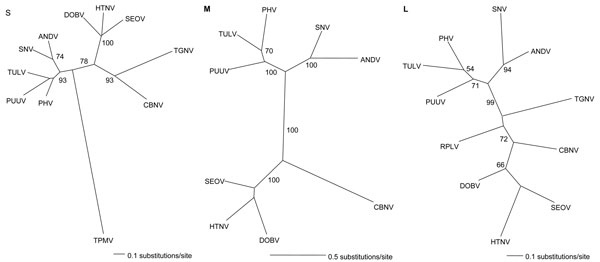Volume 13, Number 11—November 2007
Dispatch
Newfound Hantavirus in Chinese Mole Shrew, Vietnam
Figure

Figure. Phylogenetic trees based on the 1,185-nt partial small (S), 3,637-nt full-length medium (M), and 412-nt partial large (L) segments of Cao Bang virus (CBNV). The depicted S tree was generated by the neighbor-joining (NJ) method, by using the GTR+I+G model of evolution as estimated from the data. The M and L trees were generated by the maximum likelihood (ML) method, using the same model of evolution. The phylogenetic position of CBNV is shown in relationship to representative Murinae rodentborne hantaviruses, including Hantaan virus (HTNV 76–118, GenBank accession nos. NC_005218, NC_005219, NC_005222), Dobrava virus (DOBV Greece, GenBank accession nos. NC_005233, NC_005234, NC_005235), and Seoul virus (SEOV 80–39, GenBank accession nos. NC_005236, NC_005237, NC_005238); Arvicolinae rodentborne hantaviruses, including Tula virus (TULV M5302v, GenBank accession nos. NC_005227, NC_005228, NC_005226), Prospect Hill virus (PHV PH-1, GenBank accession nos. Z49098, X55129, EF646763) and Puumala virus (PUUV Sotkamo, GenBank accession nos. NC_005224, NC_005223, NC_005225); and Sigmodontinae and Neotominae rodentborne hantaviruses, including Andes virus (ANDV Chile 9717869, GenBank accession nos. NC_003466, NC_003467, NC_003468) and Sin Nombre virus (SNV NMH10, GenBank accession nos. NC_00521, NC_005215, NC_005217). Also included are Thottapalayam virus (TPMV VRC-66412, GenBank accession no. AY526097), Tanganya virus (TGNV Tan826, GenBank accession nos. EF050454, EF050455), and Camp Ripley virus (RPLV MSB89863, GenBank accession no. EF540771). NJ, ML, and maximum parsimony phylogenetic methods yielded similar topologies with only minor cosmetic differences. Host identification was confirmed by diagnostic mitochondrial DNA sequences (GenBank accession no. EF543528). The numbers at each node are bootstrap probabilities (expressed as percentages), as determined for 1,000 (NJ) and 100 (ML) iterations by PAUP* version 4.0 (Sinauer Associates, Inc. Publishers, Sunderland, MA, USA) (http://paup.csit.fsu.edu). GenBank accession nos. for CBNV: S (EF543524); M (EF543526); and L (EF543525).